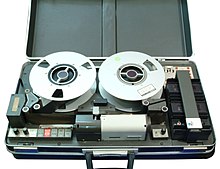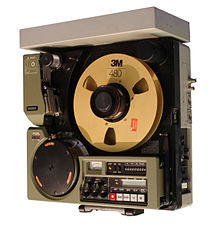


A video tape recorder (VTR) is a tape recorder designed to record and playback video and audio material from magnetic tape. The early VTRs were open-reel devices that record on individual reels of 2-inch-wide (5.08 cm) tape. They were used in television studios, serving as a replacement for motion picture film stock and making recording for television applications cheaper and quicker. Beginning in 1963, videotape machines made instant replay during televised sporting events possible. Improved formats, in which the tape was contained inside a videocassette, were introduced around 1969; the machines which play them are called videocassette recorders.
An agreement by Japanese manufacturers on a common standard recording format, which allowed cassettes recorded on one manufacturer's machine to play on another's, made a consumer market possible; and the first consumer videocassette recorder, which used the U-matic format, was introduced by Sony in 1971.[1]